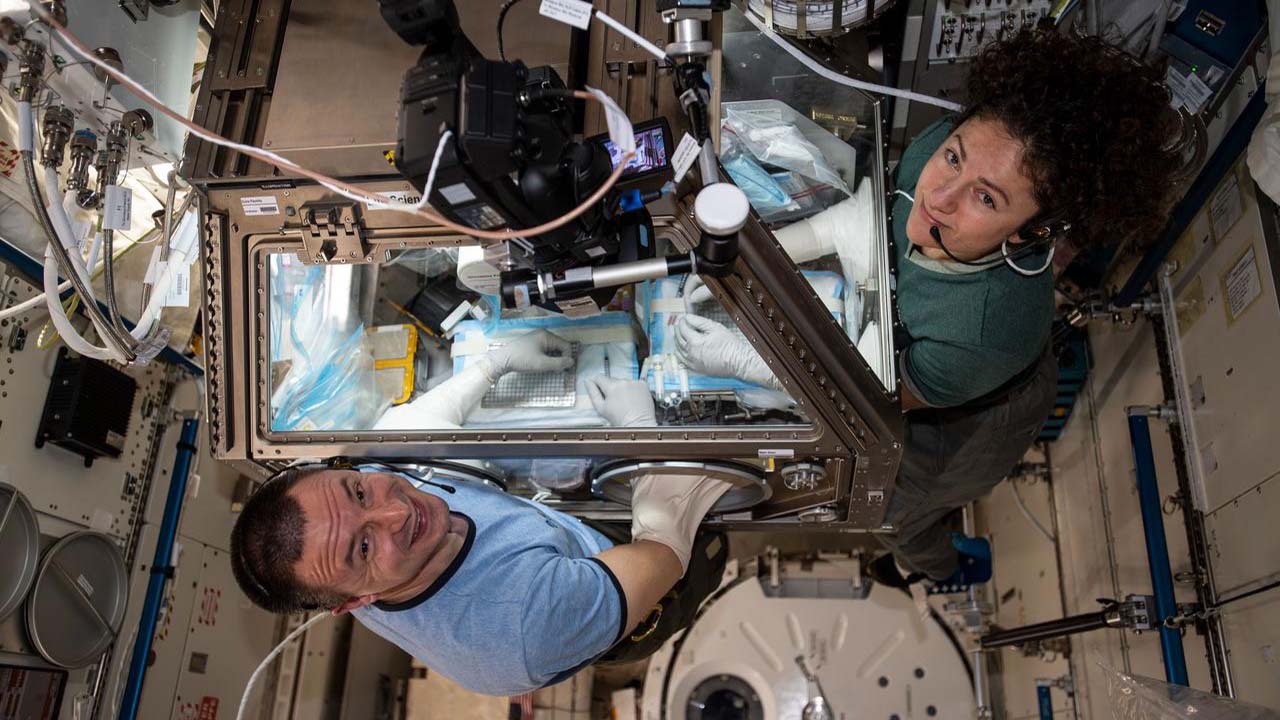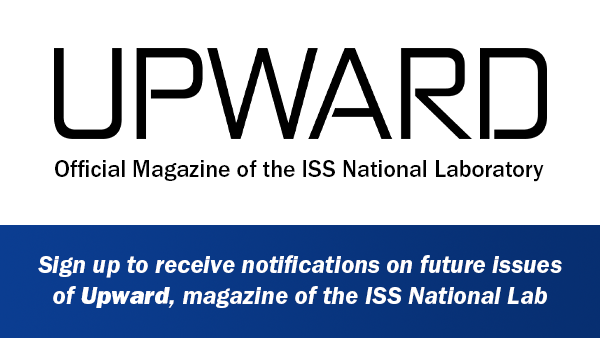People usually think of bone and muscle as very different things. Bones support the body and give it shape, while muscles provide the strength to move. When now-married scientists Emily Germain-Lee and Se-Jin Lee first met in college, they were studying what they thought were separate fields: Germain-Lee focused on bone and Lee focused on muscle. However, they eventually came to realize that bone and muscle are very much tied together—in fact, they are two sides of the same coin.
“Over the past couple decades, we’ve started to see just how intertwined bone and muscle are,” said Germain-Lee, a pediatric endocrinologist and professor at the University of Connecticut School of Medicine. “If the muscles aren’t putting traction on the bones, then you’re not going to have strong bones, and vice versa.”

Researchers Emily Germain-Lee and Se-Jin Lee watch as their research launches to space onboard a SpaceX Falcon 9 rocket.
Media Credit: Image courtesy of Benjamin Charles Germain-Lee
Because muscles and bones rely on each other to stay strong, the elderly and others with bone and muscle loss can end up in a cycle that is hard to break. “Really, anybody who has a chronic condition can become bedridden,” Germain-Lee said. “It’s one reason why nursing homes are packed—people break their bones, and then their muscles get weak, and they’re just in bed, potentially even immobilized for the rest of their life.”
To help patients such as these, Germain-Lee and Lee turned to an unexpected hero: Mighty Mice in space. The couple came together to leverage the International Space Station (ISS) National Laboratory for research that combined their areas of expertise. They conducted a rodent research investigation to see what happens when two proteins involved in muscle and bone loss—myostatin and activin A—are inhibited.
Ground studies showed that mice genetically engineered to lack myostatin developed twice the muscle mass of normal mice, hence the name “Mighty Mice.” Because microgravity induces muscle and bone loss at an accelerated rate, Lee and Germain-Lee wanted to see what happened to Mighty Mice in space. “Going to space is the ultimate bed rest,” said Lee, a physician and researcher at the Jackson Laboratory in Maine who provided the mice for the experiment. “So, microgravity has been instrumental in this research.”
The team’s findings, published in an article in the journal PNAS, revealed that inhibiting the proteins provided significant protection from muscle and bone loss in microgravity—results that could lead to new therapies for patients on Earth. “That’s what really captured me,” said Germain-Lee. “I saw the possibilities of what we could gain from this research, and if we had a positive result, it could really help prevent muscle and bone loss. I thought of all the people it could potentially help, and that was incredibly gripping.”
Targeting Proteins Linked to Muscle and Bone Loss
In 1997, Lee had a eureka moment: he identified a gene that plays a pivotal role in regulating muscle mass. The gene triggers production of a protein called myostatin, which limits muscle growth. He discovered that if you inhibit, or block, this gene in mice, they become hypermuscular, with their muscles growing to about twice the normal size.
“That immediately suggested the possibility that if we could find a way to target this protein, it might have clinical applications to treat people with muscle loss from a wide range of conditions,” Lee said. “We thought it might be a good way to develop a new therapeutic strategy to help people recover muscle mass and strength.”

A view of a wild-type mouse (left) compared with a mouse treated with the myostatin inhibitor (right) from a prior ground-based experiment. The treated mouse displays increased muscle mass.
Media Credit: Image courtesy of Se-Jin Lee (2007) Quadrupling muscle mass in mice by targeting TGF-ß signaling pathways. PLOS ONE 2(8):e789. doi:10.1371/journal.pone.0000789.
Lee said he then thought of astronauts in space and how, without countermeasures, they lose bone and muscle mass at an accelerated rate. It was then that he first realized he wanted to send his Mighty Mice to space. Lee petitioned NASA to conduct an experiment in space to examine how blocking the myostatin gene would affect muscle growth in mice. While he could not secure a flight in the late 1990s, Lee and others went on to discover that muscles are not the only thing affected by this gene blocking. Myostatin also affects bones.
Lee’s subsequent research led to a partnership with Pfizer to develop a therapeutic that binds to myostatin to block it. Lee also found that myostatin does not work alone. Another protein, Activin A, also helps regulate muscle and bone mass.
Germain-Lee, who specializes in rare bone diseases in children, was excited about the findings. She was using mice to study a bone disorder in children, osteogenesis imperfecta (otherwise known as brittle bone disease), which affects collagen production within bones, making them incredibly weak and prone to fracture.
“A child with osteogenesis imperfecta could have 100 fractures by the time they’re 10 years old, and that’s no exaggeration,” said Germain-Lee.
Children with this condition are often immobilized, leading to muscle atrophy, which makes physical therapy to strengthen their bones nearly impossible. Germain-Lee thought that blocking both myostatin and activin A would theoretically result in increased bone and muscle mass, which would greatly benefit children with brittle bone disease.
“We were working with mice that had osteogenesis imperfecta, and when we treated the mice to block myostatin and activin A, we saw increased bone and muscle mass,” she said. “So, for me, that was incredibly exciting.”
Mighty Mice in Space
Through the years, the idea of sending Mighty Mice to space never left the minds of Lee and Germain-Lee, both of whom have been fascinated with space since they were young.
“Everybody our age has some shared memories of space,” Lee said. “We all remember watching the black and white TV and seeing Neil Armstrong and Buzz Aldrin walk on the Moon.”
Germain-Lee said seeing Sally Ride fly to space when she was in medical school inspired her. “I can remember when Sally Ride was the first American woman in space, and I thought it was incredible,” she said. “In those days, even as a physician, you weren’t in the majority as a woman.”
A few years ago, when the opportunity to send an investigation to space through the ISS National Lab came up, Germain-Lee and Lee jumped at the chance. They proposed an experiment to evaluate the effects of inhibiting myostatin and activin A on microgravity-induced muscle loss. The investigation featured 40 female mice, which included normal (or wild-type) mice, wild-type mice treated with an agent that inhibits myostatin and activin A, and genetically mutated Mighty Mice that lacked the myostatin gene.
The mice stayed onboard the orbiting laboratory for just over a month, while the researchers ran a control group consisting of the same types of mice on the ground to compare the results. While on station, the ISS crew monitored the mice, measuring their bone density, observing changes in muscle mass, and administering the inhibitor agent.
While in space, the wild-type mice lost significant bone and muscle mass, which corresponds to what we know about microgravity and the human body. However, the Mighty Mice responded differently. “The Mighty Mice had extra muscle mass as a result of having a mutation in the myostatin gene and were able to retain most, if not all, of that extra muscle during spaceflight,” said Lee.

NASA astronaut Jessica Meir uses a bone densitometer on the space station to measure each mouse’s bone density throughout the experiment.
Media Credit: Image courtesy of NASA
While working with the mice onboard the ISS, NASA astronaut and biologist Jessica Meir said she was surprised at how noticeable the differences were between the normal mice and Mighty Mice. “Holding these mice, I could not only see the difference between the two groups of mice, but I could also feel how much more muscle mass the Mighty Mice had,” she said.
Similarly, the wild-type mice treated with the agent that inhibits myostatin and activin A did not lose muscle and bone mass while in space. In fact, they experienced a significant increase in both. The increases in bone and muscle mass in the treated mice in microgravity were comparable to the increases in the treated mice on the ground. This means that the spaceflight mice were protected from microgravity-induced bone and muscle loss by the treatment.
“As astronauts, we have to exercise every day to prevent bone and muscle loss,” Meir said, “so having the opportunity to work on an experiment that could directly relate to a problem I faced was really rewarding.”
Benefiting People on Earth and Beyond
Lee explained that the findings show that blocking the activities of myostatin and activin A works to enhance both muscle and bone, even when mice cannot bear weight, which could have significant implications for people on Earth. Targeting this pathway could be used to help people with disuse atrophy, said Lee, specifically the elderly and those who are bedridden or use a wheelchair. It could also be beneficial for those who experience muscle and bone loss due to conditions such as muscular dystrophy, osteoporosis, cancer, heart disease, sepsis, and AIDS.
“For many patients with these serious conditions, like cancer and AIDS, muscle wasting is the leading cause of death,” Lee said, “Mitigating the amount of muscle mass lost would be game-changing.”

Team Mighty Mice poses for a photo before their experiment launches to space.
Media Credit: Image courtesy of Emily Germain-Lee
The results could also have important implications for astronauts. In microgravity, nothing puts force on bones and muscles, so astronauts in space must exercise for two or more hours each day to mitigate bone and muscle loss. This research could lead to therapies that help future space travelers on long-duration missions and brief stays in low Earth orbit.
“The whole concept of this research helping astronauts really impacted me,” Germain-Lee said. “Astronauts opened up a whole new world when I was a kid and seeing women like Sally Ride do these kinds of things was incredibly empowering.”
Although it will be a long road to developing a treatment for patients, Germain-Lee said their space-based investigation was an important step forward. “There is still a lot of work that needs to be done,” she said, “but we believe that this strategy holds promise and ultimately can improve the quality of life for many patients.”








